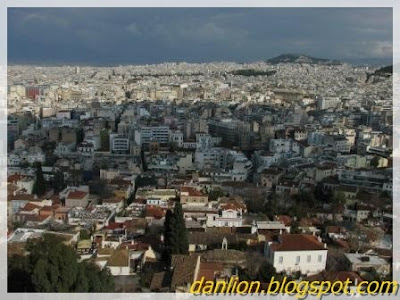The weather was fine, sunny, no rain, and a great time to walk at Acropolis.
Acropolis
View of the Parthenon from the bottom of the hill.



Reference Site plan of the Acropolis at Athens showing the major archaeological remains
http://en.wikipedia.org/wiki/File:AcropolisatathensSitePlan.png
To Acropolis...

Theatre of Dionysus Eleuthereus
The Theatre of Dionysus was a major open-air theatre in Athens, built at the foot of the Acropolis and forming part of the temenos of "Dionysus Eleuthereus" ("Dioe Liberator"). Dedicated to the god of wine and fertility, it hosted the City Dionysia festival.
Reference http://en.wikipedia.org/wiki/Theatre_of_Dionysus





The Stoa of Eumenes
The Stoa of Eumenes is a stoa on the acropolis of Athens, sited between the Odeion of Herodes Atticus and the Theater of Dionysos. It was built against the slope of the hill (meaning it needed a retaining wall supported by piers and round arches...
Reference http://en.wikipedia.org/wiki/Stoa_of_Eumenes


Other pictures on the way up to the hill.




Sanctuary of Asclepius

Odeon of Herodes Atticus
The Odeon of Herodes Atticus is a stone theatre structure located on the south slope of the Acropolis of Athens. It was built in 161 AD by Herodes Atticus in memory of his wife, Aspasia Annia Regilla. It was originally a steep-sloped amphitheater with a three-story stone front wall and a wooden roof, and was used as a venue for music concerts with a capacity of 5,000.
Reference http://en.wikipedia.org/wiki/Odeon_of_Herodes_Atticus




Propylaea
A Propylaea, Propylea or Propylaia (in Greek — Προπύλαια) is any monumental gateway based on the original Propylaea that serves as the entrance to the Acropolis in Athens. The word propylaea (propylaeum is the Latin version) is the union of the prefix pro (before or in front of) plus the plural of the Greek pylon or pylaion (gate), meaning literally that which is before the gates, but the word has come to mean simply gate building.
Reference http://en.wikipedia.org/wiki/Propylaea







Parthenon
The Parthenon (Ancient Greek: Παρθενών) is a temple of the Greek goddess Athena whom the people of Athens considered their protector.
Reference http://en.wikipedia.org/wiki/Parthenon










This is not an ancient relic, it a drinking water fountain.

Sanctuary of Pandion
The Sanctuary of Pandion was an open-air sanctuary or shrine at the south-east corner of the Acropolis of Athens, dedicated to Pandion I or Pandion II.
Reference http://en.wikipedia.org/wiki/Sanctuary_of_Pandion



Erechtheum
The Erechtheum (Greek: Ἐρέχθειον Erechtheion) is an ancient Greek temple on the north side of the Acropolis of Athens in Greece.
Reference http://en.wikipedia.org/wiki/Erechtheum






Erechtheum: The Porch of the Caryatids
On the north side, there is another large porch with columns, and on the south, the famous "Porch of the Maidens", with six draped female figures (caryatids) as supporting columns, each sculpted in a manner different from the rest and engineered in such a way that their slenderest part, the neck, is capable of supporting the weight of the porch roof whilst remaining graceful and feminine. The porch was built to conceal the giant 15-ft beam needed to support the southwest corner over the metropolis, after the building was drastically reduced in size and budget following the onset of the Peloponnesian war.
Reference http://en.wikipedia.org/wiki/Erechtheum




Athens from the Acropolis











Reference sites:
http://en.wikipedia.org/wiki/Acropolis_of_Athens
http://www.ancient-greece.org/archive/acropolis.html
No comments:
Post a Comment